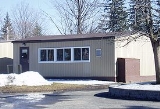
Portable classroom
Encyclopedia


Australian English
Australian English is the name given to the group of dialects spoken in Australia that form a major variety of the English language....
a demountable and often referred to as a demountable, a "Terrapin" or a "Portakabin" (after the two companies) in the UK and called a prefab in Ireland (not to be confused with a prefabricated building) is a temporary building installed on the grounds of a school
School
A school is an institution designed for the teaching of students under the direction of teachers. Most countries have systems of formal education, which is commonly compulsory. In these systems, students progress through a series of schools...
to provide additional classroom
Classroom
A classroom is a room in which teaching or learning activities can take place. Classrooms are found in educational institutions of all kinds, including public and private schools, corporations, and religious and humanitarian organizations...
space where there is a shortage of capacity. Such a classroom would be installed much like a mobile home
Mobile home
Mobile homes or static caravans are prefabricated homes built in factories, rather than on site, and then taken to the place where they will be occupied...
, with utilities often being attached to the main building to provide light and heat for the room. It would be removed once the capacity situation abates, whether by a permanent addition to the school, another school being opened in the area, or a reduction in student population.
Sometimes, the portable classrooms are meant to be long-lasting and are built as "portapacks". A portapack combines a series of portables and connects them with a hallway. Portapacks are usually separated from the main building but can connect to the school. In most cases, portapacks are accompanied with a few separate portables.
Portable classrooms are also colloquially known as bungalows, t-shacks, trailers, terrapins, huts, portables, or relocatable classrooms.
Occupant health and building durability issues
Portable classrooms are frequently criticized for presenting mold, moisture, comfort and unhealthy environment issues.However, when portable classrooms are properly set up and operated, experience has shown that they can present a very long useful life, low maintenance, and healthy, comfortable environments for all occupants.
In the United States, there are approximately 300,000 portable classrooms in use. About half of those are school owned and of unknown age. The other half are owned by modular leasing companies and are between 5 and 6 years old on average.
If properly installed and maintained, a portable can have a useful life of approximately twenty years. Certain factors impact useful life, including capital improvements and the number of times a unit is relocated.
A portable classroom can be any number of modular sections wide and typically is only 2 stories high, but can be over 3 levels. http://www.portableoffices.co.uk/content/3-Education-and-Training
Smart practices
In hot, humid climates (in order of importance):- Utilize demand control ventilation to reduce moisture loads on dehumidification equipment while providing precisely correct ventilation rates for the occupants at all times. DCV will immediately increase and decrease the ventilation rates as occupants come and go and will do it within seconds. Correct and economical ventilation of portables almost never occurs, even in the newest designs. A good DCV design can also maintain essential positive building pressurization. Sophisticated DCV retrofits for existing air conditioning units are available.
- Never use wall finishes that can slow the release of moisture from the walls and into the breathing zone where the water vapor can be removed by dehumidification (vinyl wall covering, gloss or semi gloss paint, foil, mirrors).
- Prevent any depressurization/pressurization of the exterior wall cavities by air conditioner operation. This is very simple and easy to accomplish but is almost never done.
- Ensure that the exterior shell or pressure envelope is air and moisture tight to prevent entry of water vapor as well as water.
- Correct roof leaks immediately. Poor workmanship and improper material use is more than common.
- Never close off the ventilation air intakes in an attempt to control moisture or humidity problems. To do so almost always causes the building to become negatively pressurized with terrible mold and moisture problem consequences.
- Ensure that the air conditioner can maintain a temperature drop of about twenty degrees as the air passes through the cooling coils.
- Use occupancy sensors to operate exhaust fans when bathrooms become occupied and for a few minutes after they become vacant. Use significantly reduced exhaust airflow rates when vacant.
- In hot, humid climates, expect that mold and moisture issues will be worst in the late fall and early spring when air conditioners are not often operating and dehumidifying indoor air. Use dehumidifiers during such periods.
Modular buildings shorten the time to construct deadline-driven school facility projects. Whether growing enrollment, modernization or budgets are driving temporary building needs, portable classrooms allow speed and flexibility to adjust to the demands of a school's student population. http://mobilemodularrents.com/modular/Portable_Classrooms.asp
External links
- Modular Building Institute - The international trade association representing non residential modular construction professionals.
- http://www.terrapin-ltd.co.uk/education.php" - Terrapin Portable Classrooms

